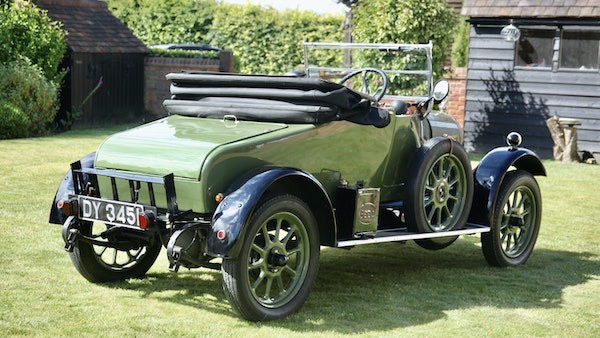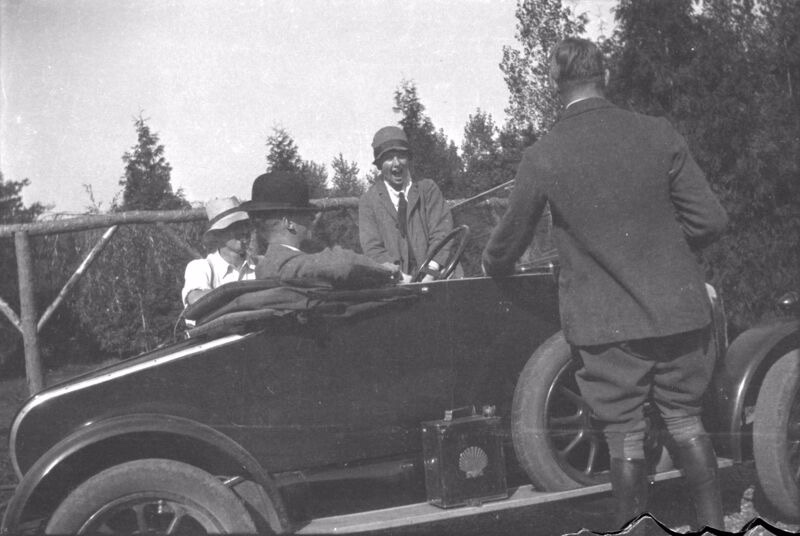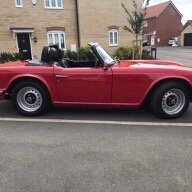-
Content Count
1,212 -
Joined
-
Last visited
Content Type
Profiles
Forums
Calendar
Posts posted by MilesA
-
-
6 hours ago, stuart said:
Been heavily restored by the looks of it. Still a lorry to drive compared to a TR.
Stuart.
Such a relief to read that Stuart. I thought it was just me!
Always loved the look of the big Healey and the idea of 6 cylinders. Couple of years ago I got the chance to drive a friends very expensive, late model as I was starting to seriously think about buying one. I was absolutely gutted. As you say, it drove like a lorry (or even a tank!). My humble 3A was so much better to drive. So got the wind up windows, better handling and 6 cylinders (as well as copious support here) by buying a 6 for way less money.
Miles
-
Well, an update.
I started to release anchor bolts with some trepidation but they came out without any drama. A little surface rust colour on the end of the bolts and in the thread but otherwise fine and the base of the B post are solid. Copperslip on the way back in I think unless there are any other suggestions.
The bolts for the seat belt swivels on the top of the wheel arch were much more challenging, requiring copious amounts of penetrating fluid and repeated winding in and out as Stuart advised. In fact one of them is still in place after a couple of hours. Winds about half way out, then gets tight and tighter and then binds solid. Was going to get a nut on the end of the bolt in the wheel arch but of course I have every size nut except a 7/16 UNF and don't want to damage the two that hold the reels (which came off easily). So if the penetrating fluid hasn't done the job when I can next face the freezing lock up, I will try using my battery Dremel with a wire wheel and running a die along the end of the offending bolt
Thanks all
Miles
-
Thanks for the tip Stuart. Slowly does it…!
Miles
-
Thanks guys. I’ll get spannering!
Miles
-
I am being super cautious so asking what I am confident is obvious.
The post title says it all. I want to replace the trim panels above the rear wheel arches. They are secured partly by the seat belt bolt. Everything I have read assumes that there is a welded nut inside the B post to which the bolt securing the end of the seat belt is attached. Is this in fact the case? Logic says they should be as the B post is enclosed. Don’t want to undo it then find I have a massive problem re securing the bolt!
Having removed the seats and runners to replace the carpets, it was great to find that the nuts were welded to the floor plan unlike my 3A when I spent ages scrabbling under the car to re secure all the runners and seat bolt nuts after installing a new carpet.
Thanks for your indulgence!
Miles
-
Indeed. Happy Birthday. Hope you can get the TR out for a suitable drive and photoshoot.
Miles
-
33 minutes ago, Chilliman said:
It was a cracking day Hamish, met loads of old friends & bought a load of stuff I didn't know I needed.
+1!
-
As in previous years, I expect that once the detailed schedule is released, an exchange of suggestions for time and location will take place here and a consensus will be reached. looking forward to meeting Forum friends again in August.
Miles -
John
If you cannot download, just screenshot it. I use this function a lot for parts of documents, photos etc.
Miles
-
18 hours ago, Swscar said:
My gear stick gaiter needs replacing but I’m having great difficulty in removing the black plastic tear drop shaped gear knob. I’m a bit concerned that if I put too much turning effort trying to unscrew it that I may do some damage to the gear lever or the gear box mechanics itself. Any ideas?
1974 CR 6
sws
Agree that it should just unscrew unless previously glued / screwed.
Assuming it is the vinyl gaiter you are replacing, interested to know how it is replaced. Mine is tatty and irritates me every time I look at it!
ThanksMiles
-
Pete
Yet another masterclass! Thank you for sharing again so fully.
I bid you a warm and comfortable Christmas and a New Year of many miles under your wheels.
Miles
-
Charlie
The older I get, the more I realise how stupid I am!
Miles
-
11 hours ago, RobH said:
That is a very good point. We are all assuming the fault is in the boiler but that may not be the case.
Boilers are part of a system that usually includes a timer (programmer) and thermostats. If the boiler heats a hot water cylinder as well as radiators, there are usually one or more motorised zone valves which 'steer' where the water goes. The room and tank thermostats operate the appropriate valves and the valves in turn have switches which send power to the boiler only when the valve has reached full travel.
The boiler and water circulation pump cannot operate until they receive power from the motorised valve.
Do you know whether the water circulation pump is operating? If it is the zone valves (if present) are probably working OK but if the pump doesn't run either then maybe the fault is with a valve and not the boiler.
Just had a valve fail on our system. We have two valves: one to direct water to the hot water tank and one to direct water to the heating system. A couple of galvanised steel boxes plumbed into the pipe work and wired in. Ours each have a small lever emerging from the top of each box so one can manually override. An easy way of checking whether the valve is working.
Miles -
12 hours ago, stillp said:
Do you use enough energy during the night to offset the higher price you'll pay during the day? We had one of those 'economy' tariffs but even using the night rate for the washing machine, dryer and dishwasher we couldn't save any money, so we dropped the Economy 7 and went with a constant price tariff.
Pete
Had exactly the same experience recently. With great difficulty I got my supplier to confirm the unit costs on our Economy 7 tariff and a standard tariff. It was clear that with recent changes in pricing by the company there was even less financial benefit than there had been historically. We changed.
Miles -
Thank you for the prompt and clear responses gentlemen. A new, single earth point or a bus bar it will be, depending on space and convenience. And yes Peter, I will be mounting the relays in a block of connected holders for convenience and easy changeover in the event of failure.
I am very aware that often the questions I ask are obvious to many but as a rank amateur I have found that even with research I can come to the wrong conclusion! Also I want to ensure that any work I do or have done to my cars is of the best standard for myself and any subsequent owners and the bodgery ceases! So many thanks again.Miles
-
On the 'to do' list for my recently acquired TR6, is the installation of up to 6 relays for various existing and new components.
Unlike my 3A, I am hoping the install these together, on the inner wing, close to the fuse box and 4 way block rather than scattered about the car. All but one will need need to be earthed at that location. My question, is how best to do this? Seems to me that these are the options (but there may be others):
- earth each relay individually by screwing a cable from each separately to the body panel.
- earth each individually but use ring connectors on each earth cable going to a single new connection to the body panel.
- piggy back each earth outlet from one relay to the next with a single final cable being screwed to the body panel (not keen on this)
- use a busbar to which the earth cable from each relay is attached.
So, friends what have others done and which solution is thought to be best.
As ever, many thanks.
Miles
-
Great car Billy.
We are only custodians of them.
Stay with us.
Miles
-
14 hours ago, RobH said:
Canterbury wants to do it as well. This is another harebrained scheme from the hard-of-thinking, called the "15 minute city". It might work if you are building a new city from scratch but trying to strap it onto an existing one is crazy. Of course the left-leaning and car hating council has stated they WILL impose it without any consultation or plebiscite and despite any opposition.
https://en.wikipedia.org/wiki/15-minute_city
The idea is you aren't allowed to drive through the middle or sideways from segment to segment, so to get from one '15 minute' division to another you have to exit the city, go round the ring-road and re-enter thus bunging up the ring-road with unnecessary traffic and making people drive much longer distances than needed. Basically it means the cities will die and everyone will do their shopping in the out-of-town centres where there are fewer restrictions.
The whole thing will require a vast network of surveillance cameras and probably road blocks separating the areas. Welcome to the brave new world of total control over movement.
What is being proposed by Canterbury has been imposed in areas of north London by the car hating / money scavenging Councils of Haringey, Camden and Barnet. They are called LTNs (Local Traffic Networks). Blocks of roads so designated cannot be driven through (or in some instances even accessed unless you are a resident). The theory is that they reduce traffic and hence pollution in these areas. The practice is that: traffic becomes concentrated in adjacent roads resulting in materially increased traffic, increased pollution on those roads, extended journey times for local residents inside and close to the LTNs, increased congestion, tailbacks that never previously existed in some area of up to a mile (which is extraordinary in a built up area) and of course greater expenditure (cameras and signs), and greater income from the unwary for the Council. Local businesses have seen material reductions in business and a hollowing out of local retail facilities and the quality of the communities has started.
The LTNs are generally hated and have resulted in public demonstrations and marches but inevitably refusal by Council members to meet with protesters or have any regard for their arguments
The Councils are driven by ideology rather than evidence and their tactics and responses to the objectors are straight out of the Stalinist playbook. If it wasn’t so depressing it would be humorous to see how they behave.
Much the same could be said for the pandemic implementation of the largely deserted cycle lanes around these boroughs which also cause delay, pollution and frustration.
The publicly stated view of some of the local hard core anti car lobby is that all of this pain for motorists and detriment to them, their lifestyle as well as adverse consequences for bus services, fire services ambulances, police and local business and the quality of the communities is essential to change mindsets in pursuit of the anti car ideology. Again, an approach that Stalin would have been familiar with.
The most recent evidence of Council ideology dictating behaviour is the failure to grit many roads in the area contrary to historical norms, no doubt to keep us out of our cars. The irony is that they have also failed to grit the pavements where they are seeking to drive us all!
Having said that, there does need to be action taken to manage vehicular traffic in many of our towns that were never established before vehicle but imposition of failed mechanisms is not the way forward.
Rant over.
Miles
-
Yes, Pete. Still very much in business. Picked up a lovely pair of refurbished seats from him a couple of weeks ago. Lovely guy too.
Miles -
Knew it would be too easy for you guys! Yes, my conclusion was that it was a 1924(?) Cowley Morris Bullnose, 2 seater from the photo below. False door on the driver's side. One entered from the n/s pavement.
What a thing to have had in the family. Alas, long gone...

Miles
-
Here is another from a friend's marvellous collection of family photographs.
Took me a couple of hours research to find what I think it is. Probably, pretty easy for our readership I suspect....

Miles
-
Experienced the same yesterday on the same road. Ignorance regarding use of lights is common these days. My belief is that people assume that their daylight driving lights are doing the job in poor light conditions or heavy rain, so do not think about putting lights on.
Had just this discussion a couple of weeks ago with my two adult daughters. It hadn't occurred to them that they should put their lights on in port light conditions/visibility and had no idea about the front and rear fog lamps. I now bore them by reminding when they go out during the day and visibility is poor. There is no excuse. If you leave them on when you get out of a modern car most will alert you (as I was yesterday!).
Not helped by the difficulty in finding the front and rear fog lamps amongst the multiple options in modern cars. I struggled to find them and find out how they worked on our Outlander.
Miles
-
Thanks Deggers. Testament to quality of original engineering.
Miles -
Happy birthday Roger. Have a relaxing day and looking forward to another year of your wisdom.
Miles



B post seat belt anchor - welded nut?
in TR6 Forum
Posted
Good news - the die did it.
Bad news - when I pulled the vinyl off the wheel arch I could see the garage floor through th the gap between the arch and rotting edge of the rear shelf.
Hey, ho.
Miles